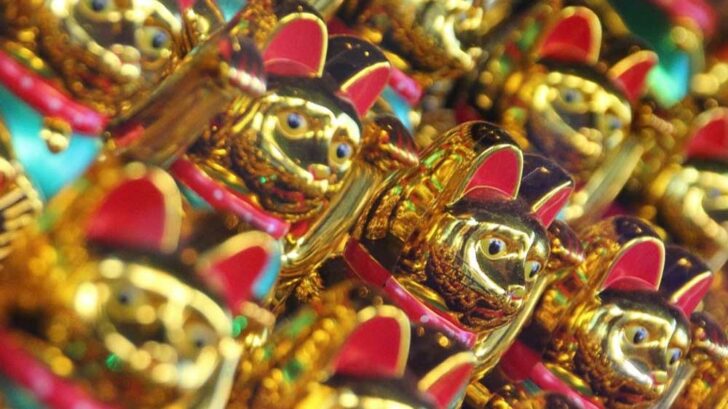The Top 5 Lucky Animals For Good Fortune

Introduction: Top 5 Lucky Animals For Good Fortune
Spend any time in a casino with Asian people, and you’ll quickly realise just how superstitious they are. It’s something deeply ingrained into their culture. To that end, they have deemed some animals to be luckier than others. Today let’s have a look at the Asian lucky animals that bring the best in good fortune.
Lucky Animals: Maneki-Neko
Go into any Chinese restaurant or store and you’ll see one of the best known lucky animals sitting by the checkout or cashier. It’s the cat that’s waving one raised paw. Known as the lucky cat, the happy cat or the fortune cat, the symbol originated from Japan. Today you can see them in Pachinko parlours all over the islands and where ever you go to gamble. The name translates to “beckoning cat”. When it comes to matters of finance and gambling, then having a Maneki-Neko nearby is an essential part of your jackpot winning strategies.
To most westerners, the cat looks as if it’s waving. But in a perfect bit of cultural misinterpretation, the cat has it’s palm down. In Japan, this is the way to beckon, hand out, palm down and waving from the wrist. In the west, we tend to beckon with the palm upwards. What’s interesting, is that for the western market, some companies produce the Maneki-Neko with the palms facing upwards.
It’s the very act of beckoning that brings good fortune. So a cat that’s keeping still doesn’t have the same effect. The left paw beckons to the customers, and the right paw brings in good luck. Some say that the raised left paw is for beckoning in the money, while a lifted right paw is done so to protect the money. The higher the paw is raised, then the more good luck will come your way. Over the years, it’s noticeable that the paws have been getting higher.

Tales of Maneki-Neko
The car’s origins are lost in the fog of time. But various folk tales tell of cats who helped their owners. One such story concerns a travelling nobleman. A cat waved to him from the side of the road. After dismounting his horse to investigate, he discovered that robbers were laid up ahead ready to attack him. Thus, thanks to the cat, he avoided a trap. Another tale tells of the owner of a poor shop, who took in and took care of a starving cat. To show his thanks, the cat would sit outside the shop beckoning customers to come in. Before long, the shop prospered.
The colour of the cat is also significant. A white cat brings happiness, purity and positive energy. A black cat is to keep evil at bay. A gold cat is the bringer of wealth. The cat with a combination of black and gold is said to be the luckiest. Then there are pink cats for love, green cats for good health, and finally red cats for having great relationships. Of course, there are many superstitions around cats the world over. If you’re gambling, some believe they can bring good luck. Especially if you choose to play at Intertops Casino.
Lucky Animals: Elephants
Elephants have particular significance in the Indian sub-continent as lucky animals. Everywhere you go, you’ll see jade elephants as good luck charms. Ganesha is worshipped by many Hindus as the God of wisdom and success. He’s also known as “The Remover of Obstacles” and has the body of a man, with the head of an elephant. The Hindu King of the Gods, Indra, has an elephant called Airavata. This elephant is known as the king of all elephants and guards the Svarga, the home of Indra.
Siddhartha Gautama was the founder of Buddhism. His mother, Maya, tells the story of a dream, where a small white elephant clasping a white Lotus flower in its tiny trunk, walked around her three times, before entering her side. She awoke immediately. Ten months later, Budda was born from Maya’s right side. Many believe that Siddhartha Gautama entered her womb through his mother’s right side in the form of an elephant.
Play Slots Online at the Intertops Casino
Elephants Are Good for Business
In many cultures where there is a prevalence of these lucky animals, they are viewed as the purveyors of wisdom, power, stability, and fertility. They are also considered symbols of good luck and protection. Having an elephant picture or carving facing the door will bring good luck as well as protecting the home. Elephant charms are thought to increase the bonds between the wearers. Many business owners like to have elephant sculptures on either side of the front door to their business. There they will provide stability and bring an increase in wealth. In fact, elephants are considered bringers of good fortune to all financial businesses.

Lucky Animals: Red Bats
In the west, we tend to regard bats as being something associated with witchcraft or haunted houses. But in China, the bat, and in particular, the red bat, is a lucky animal thought to be the bringer of good fortune. The Chinese word for “bat” and “fortune” are homonyms, meaning they sound the same but have different meanings. Red bats are often worn as lucky charms and often featured in Chinese art and paintings. The luckiest combination of red bats is five: health, longevity, wealth, virtue, and a peaceful, natural death.
Chinese mothers would often sew bat-shaped buttons on the baby’s caps as a bringer of a long and healthy life. The color red signifies joy. This is also a homonym for “vast.” When combined with the word for bat, it sounds like “vast good fortune.” Clutching a red bat amulet in the casino may bring you a winning streak and these lucky animals can show you how to win the jackpot.
Bats in Chinese Art
You’ll notice that the bats depicted in Chinese art often appear to be flying upside-down to our western eyes. Once again, this is down to a homonym. The Chinese phrase “upside-down” sounds like “to have arrived.” So, if you were to say, “the bat is flying upside-down” it would sound almost the same as saying “good fortune has arrived.” Because red bats are thought of as warding off evil, they were often depicted on the robes of the Emperor. The lucky animals are also carved into furniture and pottery.
Lucky Animals: Frogs
Going back literally thousands of years and we can find humans interacting with frogs as symbols of good luck and prosperity. In the Christian religion, the frog symbolises the spiritual evolution, as mimicked by the frog’s transition from egg to frog via the tadpole. The Ancient Australian Aborigines believed that frogs were lucky animals in that they brings rain. The Chinese painted frogs on drums used to summon rain. Frogs are considered a good symbol of lucky animals in Japan because the word for frog has a homonym with that for “return” and travellers would often carry a frog amulet to be sure of a safe journey home.

Frogs in Ancient Egypt
The Ancient Egyptians saw frogs as a symbol of life and fertility because millions of frogs were born every year after the annual flooding of the River Nile. In fact, their Goddess of fertility and childbirth, Heqet, is depicted as a woman with the head of a frog. A pregnant woman would always wear amulets depicting frogs in the hope that the lucky animal will protect the unborn child as well as ensure successful labour and birth.
The Chinese saw frogs as the protectors of their money. They will help you win jackpot games as well as guard your bankroll. These amphibians knew the secrets to immortality. In Japanese culture, it’s regarded as good fortune to have a tiny frog amulet in your purse or wallet to ensure that the money will always return. In a similar vein, some customers like to resort to using lucky objects and rituals before they go to the casino. If you’re playing casino games, then head over to Intertops Casino where they’ll help you win the jackpot online.
Lucky Animals: Crickets
The culture of viewing crickets as harbingers of good fortune goes back more than 2,000 years. Though these lucky animals were kept for their song and fighting abilities, they are also regarded as symbols of good luck and happiness. During the Tang Dynasty (618 – 906 AD) the ladies of the royal court would catch crickets and keep them in small golden cages. They would then place them next to their pillows to hear them chirping in the evenings. There’s a huge archive of Chinese stories and poems featuring crickets.
In the Song dynasty (960 – 1278 AD) crickets were used more and more for fighting. This proved to be an extremely popular sport and many matches took place at the royal palaces. Cricket fighting is still popular today. There’s a Chinese belief that these lucky animals are protectors of the home and will stop chirping when a stranger comes near. Today, it’s still a custom to offer people moving into a new house, a cricket. For the Chinese, the cricket is considered a symbol of prosperity thanks to it’s laying of hundreds of eggs. This aligns with the belief that success in life was to have as many children as possible.
Click here to visit the Intertops Casino














